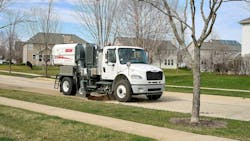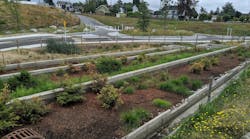Effective stormwater management: Best practices and the role of sweepers
Stormwater management is a critical aspect of urban planning and environmental protection. As cities grow and climate change intensifies, managing stormwater effectively becomes increasingly important to prevent flooding, reduce pollution and protect water quality. Below are tips for stormwater management that highlight the essential role of street sweepers in maintaining clean and safe urban environments.
Understanding stormwater management
Stormwater is the water that originates from precipitation events, including rain and snowmelt. When stormwater flows over impervious surfaces like roads, parking lots, and rooftops, it can pick up pollutants such as oil, chemicals and debris. This polluted runoff can then enter storm drains and waterways, posing risks to public health and the environment.
Effective stormwater management involves a combination of strategies to control the quantity and quality of stormwater runoff. These strategies can be broadly categorized into green infrastructure and gray infrastructure.
Green infrastructure
Green infrastructure refers to natural or engineered systems that mimic natural processes to manage stormwater. These systems aim to absorb, infiltrate, and evapo-transpirate stormwater, reducing runoff and improving water quality. Some common green infrastructure practices include:
- Rain Gardens: These are shallow, vegetated basins that capture and absorb runoff from impervious surfaces. They are designed to allow water to infiltrate into the ground, reducing the volume of stormwater and filtering pollutants. Rain gardens can be integrated into residential yards, public parks, and urban landscapes, providing aesthetic and ecological benefits.
- Green Roofs: Vegetated roofs absorb rainfall, reducing runoff and providing insulation benefits. Green roofs can also improve air quality and provide habitat for wildlife. They are particularly effective in densely populated urban areas where green space is limited. By reducing the heat island effect, green roofs contribute to cooler urban environments.
- Permeable Pavements: These pavements allow water to pass through, reducing runoff and promoting groundwater recharge. They are particularly useful in parking lots and low-traffic areas. Permeable pavements come in various forms, including porous asphalt, pervious concrete, and interlocking pavers, each suited to different applications and aesthetic preferences.
- Bioswales: These are vegetated channels that slow down and filter stormwater runoff. They are often used along roadsides and parking lots to manage runoff and improve water quality. Bioswales can be designed with native plants that enhance biodiversity and provide a habitat for pollinators and other wildlife.
Gray infrastructure
Gray infrastructure involves traditional engineered systems designed to manage stormwater. These systems include storm drains, pipes and detention basins. While gray infrastructure is essential for handling large volumes of stormwater, it often requires regular maintenance to function effectively. Detention basins, for example, temporarily store stormwater and release it at a controlled rate, reducing the risk of downstream flooding.
The role of street sweepers
Street sweepers play a crucial role in stormwater management by removing pollutants from streets before they can be washed into storm drains and waterways. Here are four key considerations for using sweepers to improve stormwater quality:
- Timing: The timing of street sweeping is critical. Sweeping before major rain events can significantly reduce the number of pollutants entering the stormwater system. In colder climates, sweeping after snowmelt helps remove sand, grit, and other materials that accumulate during winter. Regular sweeping schedules should be adjusted based on seasonal variations and weather forecasts to maximize effectiveness.
- Location: Targeting areas with high pollutant loads, such as industrial zones and busy roadways, can maximize the effectiveness of street sweeping. Regular sweeping in these areas helps prevent pollutants from accumulating and being washed into storm drains. Additionally, residential neighborhoods and commercial districts should be included in sweeping schedules to ensure comprehensive coverage.
- Frequency: Frequent sweeping is essential to keep streets clean and reduce pollutant loads. Municipalities should develop a sweeping schedule based on local conditions and pollutant sources. High-traffic areas may require more frequent sweeping compared to less busy streets. Monitoring and adjusting the frequency of sweeping can help address specific pollution challenges in different areas.
- Equipment: Using the right type of sweeper for different pavement types is important. For example, high-powered vacuum sweepers are effective for porous pavements, while regenerative air sweepers are best at sweeping up PM10, which are the primary concerns with water pollution. Investing in modern, efficient sweepers with advanced filtration systems can enhance pollutant removal and reduce environmental impact.
Benefits of proper stormwater management
Implementing effective stormwater management practices offers numerous benefits, including:
- Flood Prevention: By controlling the volume and flow of stormwater, green and gray infrastructure can reduce the risk of flooding in urban areas. This protects properties and infrastructure from water damage. Flood prevention measures also contribute to public safety by reducing the likelihood of hazardous conditions during heavy rainfall events.
- Water Quality Improvement: Reducing pollutants in stormwater runoff helps protect rivers, lakes and other bodies of water. This is essential for maintaining healthy ecosystems and ensuring safe drinking water supplies. Improved water quality supports recreational activities such as swimming, fishing, and boating, enhancing the quality of life for residents.
- Habitat Protection: Green infrastructure practices, such as rain gardens and green roofs, provide habitats for wildlife and support biodiversity in urban areas. These practices create green spaces that serve as refuges for birds, insects, and other species, contributing to urban ecological networks.
- Community Health: Clean streets and waterways contribute to a healthier environment for residents. Reducing polluants in stormwater can decrease the incidence of waterborne diseases and improve overall public health. Additionally, green infrastructure projects often involve community engagement and education, fostering a sense of stewardship and environmental awareness.
Stormwater management
Effective stormwater management is vital for sustainable urban development and environmental protection. By combining green and gray infrastructure practices, communities can manage stormwater more effectively, reduce pollution, and protect water quality. Street sweepers play an essential role in this process by removing pollutants from streets before they can enter the stormwater system. Municipalities should prioritize regular street sweeping and invest in the right equipment to maximize the benefits of their stormwater management programs.
About the Author
Chad Schiele
Chad Schiele is product manager at Elgin Sweeper.


